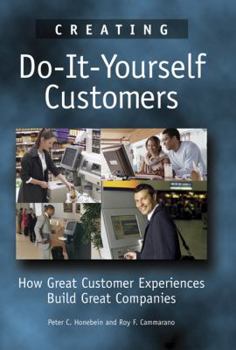Creating Do-It-Yourself Customers: How Great Customer Experiences Build Great Companies
Select Format
Select Condition 
Book Overview
More than 65 percent of Southwest Airlines' customers book tickets themselves on southwest.com. The self checkout available in more than 1,000 Home Depot stores contributed to a 7.3 percent increase... This description may be from another edition of this product.
Format:Hardcover
Language:English
ISBN:0324311540
ISBN13:9780324311549
Release Date:August 2005
Publisher:American Marketing Association
Length:264 Pages
Weight:0.35 lbs.
Dimensions:1.1" x 6.2" x 9.3"
Customer Reviews
3 ratings
Excellent from both a managerial and academic point of view
Published by Thriftbooks.com User , 18 years ago
I have just finished reading "Do-It-Yourself customers" which I consider as an outstanding piece of work on the relationships between customer experiences, customer performance and companies' performance. Specifically, the four dimensions of co-production experiences are clearly explained, well-argued and illustrated by many examples. They constitute a framework for developing any customer-performance oriented strategy. If the managerial interest of this book is evident, I also would like to stress, as a researcher in marketing, its strong academic relevance. This book brings insightful streams of research which can contribute to better understand the profitability of marketing actions. I made a doctoral research on the effects of customer education on customers' and companies performance. I had the opportunity to empirically verify certain ideas defended by the authors in their book, specifically in chapter 8 "enhancing expertise". The authors argue that developing customer expertise becomes a competitive strategy. They suggest for instance that customer education can increase customer satisfaction. Through the empirical investigation I have carried out on users of complex products, I was pleased to validate such ideas. Customers who improve their usage-related skills, become intense users of their products and are more satisfied with this product. To conclude, I would make a parallel with the paper "Defeating feature fatigue" written by Roland T. Rust, Debora Viana Thompson and Rebecca W. Hamilton published in the February 2006 issue of the Harvard Business Review. The authors reported that 9% of buyers of home networking product returned their product. They precised that (page 104): "only 15% of the returns were the result of broken or defective products; most of the remaining returns were simply because people couldn't get the equipment work" As such phenomena arise also for basic products or simple services, the propositions of Peter C. Honebein and Roy F. Cammarano to increase customer performance are more than insightful. Many thanks to the authors for this book which I had great pleasure to read.
Excellent! Actually focused on real performance issues.
Published by Thriftbooks.com User , 18 years ago
I love this book. It mixes context (history of automating self-customer interactions) with great "so what" interventions that a reader with the ability to scale, interpret, and adapt can easily apply to his/her organization. What I like about Dr. Honebein's argument is that there isn't a simple prescription or fable that will provide a pat answer-- rarely do those actually exist outside of marketing boardrooms. Instead, he provides us with a clear plan of action that does need to be contextualized because customer solutions are unique.
A Complex View of Putting Your Customers to Work
Published by Thriftbooks.com User , 18 years ago
This book's main premise may be a bit of a conceptual stretch. It notes that customers perform more services which companies formerly provided (such as booking airline reservations), and recommends that companies should encourage customers to handle even more for themselves. To accomplish this, companies should make their customers "co-producers," so every interaction becomes a "customer experience." To advance this concept, authors Peter C. Honebein and Roy F. Cammarano, both experienced business consultants, developed a model based on advising businesses to treat customers like employees, including training them to do specific tasks. For instance, companies should teach good do-it-yourself customers to move more quickly through self-service checkout lines, so the customers feel successful. The authors view even straightforward customer actions as feel-good bonding opportunities for the providing company, such as when cell phone users get to select special ring tones. While offering ample evidence of an increasing trend toward self-service, the authors combine simple examples with a perhaps overly complex model to support their premise. We recommend this book primarily to managers who are interested in exploring "customer experience" literature, and to companies that are deciding whether to put their customers to work.






